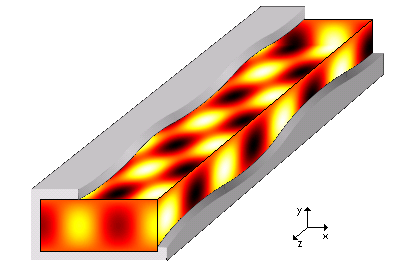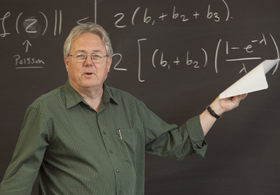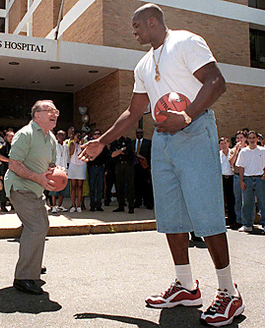By Ashley Yeager

This waveguide shows an electric field moving from right to left. Credit: Setreset, Wikimedia Commons.
Electrons typically repulse each other. But sometimes they can actually attract each other and pair up, which is why superconductors exist. The particles that make up light, on the other hand, have no charge and rarely appeal to or repel one other.
Now, Duke theoretical physicist Harold Baranger and his collaborators think it’s possible to get these particles, called photons, to pair up, and stay that way, as they travel through space.
The new idea could help with the development of quantum communications, and possibly quantum computing in the future, Baranger says.
Particles of light do not have electric charge so they’ve got no attraction to the particles around them. That lack of attraction gives photons the ability to travel long distances without losing information, a good trait for building quantum networks.
But, the photons’ reserve has a drawback. It makes it more difficult for scientists to control each particle and retrieve the information it carries. To rein in the seemingly aloof photons, physicists have designed cavities that trap them and boost their contact with individual atoms.
In these cavities, the particles pass one by one through an atom in a phenomenon called a photon blockade. But, the cavities trap the photons for a really long time, so they pass through the cavities really slowly, which isn’t good for networking — especially in this age of instant information.
Using pencil and paper, Baranger, his student Huaixiu Zheng and colleague Daniel Gauthier, figured out that they could avoid the problems with the cavities if the photons instead went into a one-dimensional structure, called a waveguide, which also channels the photons past an atom one by one.
In the waveguide, a control atom acts as an intermediary between the incoming particles. The first photon passes through the atom and changes its state.

This diagram shows a photon blockade in a waveguide. Multiple photons (left, yellow) pass by the control atom in a one-by-one manner, ending with a train of single-photon pulses and empty pulses (gray). Courtesy of Harold Baranger, Duke.
The atom then interacts differently with the next photons, which ultimately causes the two particles of light to interact. What’s surprising, Baranger says, is that the photons are still bound to each other for a long time, even as they move away from the atom that paired them.
These bound states also end up producing a photon blockade much like in a cavity, but through a completely different mechanism, and the photons move a lot faster, he says.
The work, which appears online in Physical Review Letters, “paves the way” for experimentalists who want to try to build quantum networks without using cavities, Baranger says. He says experiments in this area may be done at Duke in the next few years.
Right now, he plans to work out what happens to the photons if more than one atom sits in the waveguide. The photons will be interacting in a lot of different places, and “one can imagine that there could even be a quantum phase transition, giving rise to some new quantum state,” he says. “But, that’s just a hope at this point.”
CITATION: Cavity-Free Photon Blockade Induced by Many-Body Bound States. Zheng, H., Gauthier, D., and Baranger, H. Phys. Rev. Lett. 107, 223601 (2011).
DOI: 10.1103/PhysRevLett.107.223601













